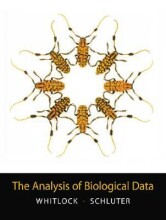Summary: Introduction To Genetic Analysis | 9781429276344 | Anthony J F Griffiths
- This + 400k other summaries
- A unique study and practice tool
- Never study anything twice again
- Get the grades you hope for
- 100% sure, 100% understanding
Read the summary and the most important questions on Introduction To Genetic Analysis | 9781429276344 | Anthony J. F. Griffiths ....
-
1 The genetics Revolution in the LIfe Sciences
This is a preview. There are 31 more flashcards available for chapter 1
Show more cards here -
Leerdoel: Explain the role of genetics in the life sciences
The impact of genetics on biological research and its applications has been so far reaching that it has been called “the genetics revolution.” Genetics is now part of the analytical framework of virtually all areas of biology. It has provided fundamental insights into all the main questions of biology that were previously unanswerable
-
KeyQ2: how is life able to persist down the generations?
Genetics has been crucial in showing mechanisms of change relevant to evolution. Even after species diverge during evolution, the DNA sequences of these species continue to show considerable similarity (homology). This DNA homology is convenient for research in that what is learned in one species can be applied to another. DNA homology is used extensively for making evolutionary trees.
-
KeyQ3: What is the basis of hereditary variation?
According to Mendel, the genotype is made of certain structures called factors. The factors controlled the inheritance of all traits. These factors are present in pairs. The factors are now called genes. Thus the physical basis of heredity are the genes or factors. The different expressions of the same genes are called alleles. Each trait may be represented with an alphabet. If the alphabet T represents height, T represents tallness and t represents shortness. If the letter R represents the colour of the flower, R represents red and r represents white.
-
KeyQ4: How has did species arise on the planet?
Mutation is the source of much variation between individuals of a species. If acted on by natural selection over time, mutation can produce new species in the process of evolution.
-
KeyQ5: How has genetics affected human society?
Human society has benefited from the genetics revolution. The deep level of understanding that genetics brings about the nature and evolution of life has allowed humans to philosophically see their own and other species in a new way and to design applications in medicine, agriculture, and industry.
-
KeyQ6: How does genetic research work?
The incisiveness of the genetic approach is based on the concept of genetic dissection: a biological function can be picked apart through the use of mutations—each mutation represents another gene in the overall program behind the function in question. Technological advances have allowed individual genes to be isolated, studied, and moved into other species for research and for making “designer organisms.” The advent of genomics has expanded genetics to allow complete gene sets (genomes) to be analyzed, further extending the ability to see complete genetic systems at work in normal and disease situations.
-
KeyQ7: How will genetics affect our future?
The future, with its increasing pressures on resources, will inevitably draw heavily on genetic technology. However, with the likely progress comes a set of ethical dilemmas surrounding the application of the new discoveries, dilemmas regarding human individuality and our treatment of other organisms and the environment. For all these issues, a firm understanding of genetics will be required to make wise decisions
-
nucleotides and which one are there?
molecular building blocks of DNA. Adenine, thymine, guanine and cytosine
-
Messenger RNA (mRnA)
The final form of gene transcription destined for protein synthesis. The word messenger is used to convey the idea that the molecule is a vehicle to transfers the information from the gene to the protein-generating machinery.
-
2 Transmission Genetics
This is a preview. There are 13 more flashcards available for chapter 2
Show more cards here -
leerdoel: Recognize and explain single-gene inheritance
- Heel het hoofdstuk
- Higher grades + faster learning
- Never study anything twice
- 100% sure, 100% understanding
































